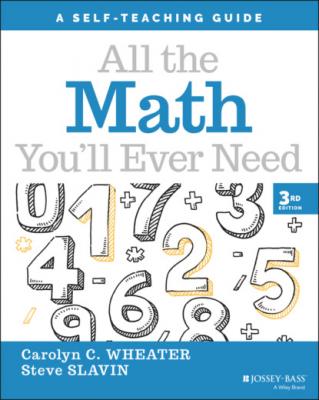All the Math You'll Ever Need. Steve Slavin
Чтение книги онлайн.
Читать онлайн книгу All the Math You'll Ever Need - Steve Slavin страница 11
 minus 2 9 3 With ̲ 3rd Row 1st Column 8 EndLayout"/>
minus 2 9 3 With ̲ 3rd Row 1st Column 8 EndLayout"/>
But this requires another regrouping. Borrow 1 from the 5 hundreds, leaving 4 hundreds, and change the borrowed hundred to 10 tens. Add that to the 7 (not 8) tens and subtract 9 from 17.
Finish by subtracting 2 hundred from the remaining 4 hundred.
4 DIVISION
Division is the opposite, or inverse, of multiplication. You can think of a division question like 21 ÷ 3 = ? as the related multiplication question 3 × what = 21? Sometimes memory is enough to answer that. You can also phrase the question as, “If you put 21 objects into groups of 3, how many groups can you make?” Another approach is to ask, “If 3 people share $21, how much does each person get?”
Division with larger numbers can get complicated. There are several methods, one of which is covered below. Others will come up in Chapter 4, “Focus on Division.” It's fair to say that division with larger numbers is one task for which calculators are helpful. If you're going to use a calculator, you'll want to be able to estimate the answer, so that you can see if the answer on the calculator is reasonable. Errors, even as simple as a typing error, can give you a wildly wrong answer.
Estimation
When you use a calculator for division, it helps to have an idea of what a reasonable answer will look like. If you divide 3,482,603 by 274 and get an answer of 12, bells should go off to say that can't possibly be right. Why doesn't that sound right? Well, think about dividing with easier numbers. 3,482,603 is larger than 3,000,000 and 274 is around 300. 3,000,000 ÷ 300 = 10,000 so the answer to the actual problem should be in that neighborhood, which means 12 must be wrong. In fact, 3,482,603 ÷ 274 = 12,710 with a little left over.
Short Division
In a division problem, you have a dividend, a divisor, a quotient, and a remainder. You don't need those labels all that often but we'll need them to talk about how to divide. If you want to divide 785 by 5, the 785 is the dividend and 5 is the divisor. If the dividend is large but the divisor is small, you can use what's called short division. It's a method that uses regrouping and compresses the work.
Set up with the dividend inside and the divisor outside, like this:
Those 2 hundreds that were left get regrouped as 20 tens so now that middle number is not just 8 but 28. Divide 28 by 5, and you get 5 with 3 left over.
Divide 35 by 5 to get 7.
Problem 1:
What is the result of dividing 161 by 7?
Solution:
Divide 7 into 16. It goes twice, so place the 2 up top, but 7 × 2 = 14, so there will be 2 left over. Write the 2 beside the 1 and divide 7 into 21. That gives you 3.
Problem 2:
Divide 1,829 by 31. Estimate first by thinking about 1,800 ÷ 30.
Solution:
Estimate your answer by thinking about how many times 30 could be subtracted from 1,800 or by thinking that 18 ÷ 3 = 6 and so 1,800 ÷ 30 would need a 6 and another zero. 1,800 ÷ 30 = 60, so expect a quotient close to 60. This one may be hard to keep all in your head, so write down as you go.
You're probably tempted to start with a 6, but if you check 6 × 31 = 186, and you're trying to divide into 182, so 6 is too big. Drop down to 5, and place 5 × 31 = 155 under the 182.
Subtract 182 – 155 = 27 and bring down the 9. Three goes into 27 nine times so there's a good chance 31 goes into 279 nine times. Multiply to check it.
If this longer division is giving you trouble, there's more on this in Chapter 4, “Focus on Division.” In the meantime, try Self-Test 2.2.
SELF-TEST 2.2
1 Subtract 384 from 497.
2 What is the difference between 2,857 and 6,793?
3 Divide 4,816 by 8.
4 When 3,751 is divided by 31, what is the result?
5 Divide 1,911 by 21.
ANSWERS TO SELF-TEST 2.1
1 1,428
2 2,662
3 51,612
4 26,730
5 15,120
ANSWERS TO SELF-TEST 2.2
1 113
2 3,936
3 602